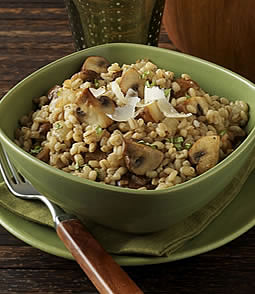Blame It on the Ouzo
01 June 2009By Albert W. A. Schmid, MA, CCP, CHE, CFBE, MCFE, CCE, CEC, COI, Sullivan University
Or, my big fat Greek dinner during the NRA Show in Chicago.
I discovered Greek cuisine in Lincoln, Neb., at a small eatery called Papa John’s when I was studying at the University of Nebraska. No, this establishment had no relation to the franchised pizza parlor. It was located a few blocks away from campus and came complete with a large Greek family that could have been cast in the Hollywood movie, My Big Fat Greek Wedding. Each member of the entire family had tons of personality. The father and sons ran the kitchen while the mother and daughters tended to the tables and front of the house. The family always seemed to have fun working together in the restaurant. The food portions were as large as the owners’ personalities, perfect for a hungry college student.
One of the reasons I enjoyed eating there was the ouzo, an anise-flavored liqueur. There were many nights when I consumed more than one shot of ouzo with my meal. I always enjoyed the atmosphere of the restaurant. Every meal was a celebration. Since then I have had many Greek meals, and it always invokes memories, feelings and smells of my time in the Cornhusker State and that little Greek eatery.
Last year I traveled to Chicago to attend the National Restaurant Association Show. That was a fun-filled but intense weekend; lots of things to see, lots of people to meet. Every night we would try another restaurant and another cuisine. On the last night someone in my party suggested that we travel to Greektown for dinner. The cab dropped us off at the restaurant and we proceeded in to get a table. The first thing ordered was ouzo. We toasted each other and downed the beverage. For a moment I was transported to the past. In the study of gastronomic tourism there is a term for the traveling of time and place in the mind based on the ingestion of food: sense of place. I am sure that if my first experience with this cuisine had been in Greece I would have been transported back to some Greek Island, but for this moment I was back in Lincoln, Neb., in my junior year at the university.
It occurred to me that Greek cuisine showcases the country’s physical place in the Mediterranean Basin through the food. Greece is at the center of the region. When looking at Greek cuisine one can see other parts of the Mediterranean such as Spain, Italy and the Middle East. A few millennia of regional trading undoubtedly blended these cuisines.
A Meal to Remember
After the ouzo, on to the food! We started with taramosalata (a purée of roe from gray mullet or orange carp, lemon juice, milk-soaked breadcrumbs, olive oil and seasonings), saganaki (fried kasseri cheese), tiropitakia (cheese triangles wrapped in phyllo and baked), and lahano dolmathes (cabbage rolls filled with spiced lamb and rice). The appetizers were passed around and could have made a meal alone. The flavors reminded me of the food in Lincoln, and to me were authentic.
After another shot of ouzo we moved to the entrées. We ordered seven entrées for five people and passed the plates so that everyone could try the moussaka (the Greek answer to lasagna without pasta that features ground lamb), kokopoulo me syko (chicken with figs), spanakopita (a phyllo pie filled with Swiss chard and cheese), oktapodi krasato (octopus cooked in red wine), kalamaria tiganita (fried squid), roast lamb with lemon and potatoes, and pastitsio (meat and pasta bake). We devoured the food. The staff seemed to have as much fun serving the food as we did eating it. At this point I had consumed more in one sitting than I usually eat in three days.
After another shot of ouzo we decided to move to the desserts. Again we ordered a variety to share: kourambiethes (almond shortbread), kataifi me amigthala (shredded pastry with almonds), melomakarona (honey biscuits) and coffee.
That was our last night in Chicago. After the meal we climbed into the cab and headed off to our hotel. The next morning I woke up early and headed down for breakfast. Compared to the meal the night before, breakfast fell flat. Later in the day on the cab ride to Midway Airport we all sat silently in our seats staring out the windows. We were five gastronomic adventurers shell-shocked at the end of a long weekend. We boarded a plane to head back to Louisville.
There are a few meals that stick out in my mind. The meals that do celebrated life and the short time we have to enjoy all the pleasures life brings. This meal was especially festive and everyone at the table seemed to live in the moment. The service was good, the food was great, and in the end I will never forget that meal or the way it took me back to my college days. Blame it on the ouzo!
What is Mediterranean cuisine?
 The Mediterranean region is a vast area spanning across Europe, Africa and Asia, including 21 countries composing the Mediterranean’s coastline. Since ancient times, the Mediterranean Basin has been a site of dynamic cultural exchange, and its diverse cuisine reflects a long history of trade, occupations and conquests.
The Mediterranean region is a vast area spanning across Europe, Africa and Asia, including 21 countries composing the Mediterranean’s coastline. Since ancient times, the Mediterranean Basin has been a site of dynamic cultural exchange, and its diverse cuisine reflects a long history of trade, occupations and conquests.
Mushrooms are an essential, authentic part of Mediterranean foods across the region’s diverse cuisines. Mushrooms’ earthy, meaty, satisfying and versatile flavor profile complements any Mediterranean dish.
The Mushroom Council offers a two-page PDF file perfect as a color handout during class instruction on Mediterranean cuisine. Download “DISCOVER MUSHROOMS ... the hidden treasure of the Mediterranean”.

Albert W.A. Schmid, MA, CCP, CHE, CFBE, MCFE, CCE, CEC, COI, teaches and is an academic adviser at Sullivan University’s National Center for Hospitality Studies in Louisville, Ky. He is the author of Hospitality Manager’s Guide to Wines, Beers and Spirits (Prentice Hall, 2003) and The Kitchen Manager’s Guide to Wine (2007). He sits on the editorial board for The Journal of Culinary Science and Technology. Schmid earned the Le Cordon Bleu Master of Arts in Gastronomy from the University of Adelaide in 2006 and was the 2002 Le Cordon Blue/University of Adelaide scholarship recipient through the International Association of Culinary Professionals.
